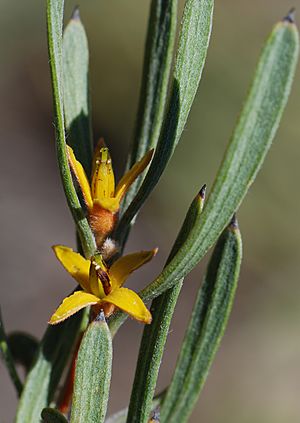Persoonia trinervis facts for kids
Quick facts for kids Persoonia trinervis |
|
|---|---|
 |
|
| Near Brookton | |
| Scientific classification | |
| Genus: |
Persoonia
|
| Species: |
trinervis
|
| Synonyms | |
|
|
Persoonia trinervis is a type of flowering plant that belongs to the Proteaceae family. You can only find it naturally in the south-west part of Western Australia. It's a shrub that stands upright, or sometimes spreads out. Its young branches are quite hairy. The leaves are shaped like a spatula or a spear, wider at one end and narrower at the base. This plant also has yellow flowers that are very hairy.
What it Looks Like
Persoonia trinervis is a shrub that can grow from about 0.3 to 1.8 meters tall. Its young branches are covered with thick, greyish or rust-colored hairs.
The leaves are shaped like a spatula or a spear. They are wider at one end and narrower at the base. These leaves are usually between 15 and 70 millimeters long. They are also 3 to 10 millimeters wide. You can see three or six clear lines, or veins, running through them. Sometimes, the leaves can even twist up to two full turns!
The flowers grow either alone or in small groups of up to four. Each flower sits on a short, hairy stalk called a pedicel. This stalk is about 1 to 3.5 millimeters long. At the bottom of each stalk, there's a small scale-like leaf. The flower parts, called tepals, are yellow. They are 8.5 to 16 millimeters long and have many hairs on the outside.
Persoonia trinervis flowers from September to December. After flowering, it produces a smooth, oval-shaped fruit. This fruit is a type of drupe, which means it has a hard pit inside, like a peach or a cherry.
How it Was Named
The plant Persoonia trinervis was first officially described in 1855. This description was made by a scientist named Carl Meissner. He wrote about it in a book called Prodromus Systematis Naturalis Regni Vegetabilis. The information came from plant samples collected by James Drummond. He found these samples in an area then known as the Swan River Colony.
Where it Grows
This special plant, also known as a geebung, grows in certain areas of Western Australia. You can find it in heathlands and mallee woodlands. These areas are located between Mount Peron near Jurien Bay, Lake Grace, Frank Hann National Park, and Watheroo. All these places are in the south-west part of Western Australia.
Conservation Status
The Government of Western Australia's Department of Parks and Wildlife has looked at Persoonia trinervis. They have decided that this plant is "not threatened." This means there are enough of these plants in the wild, and they are not currently at risk of disappearing.

